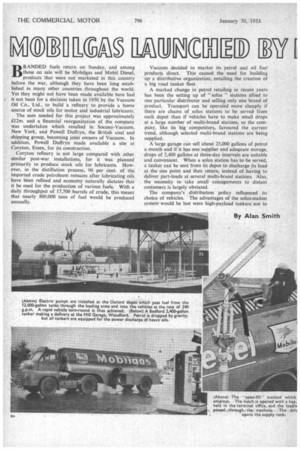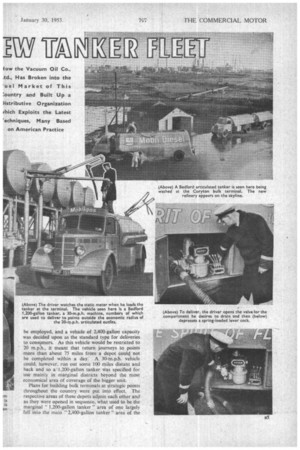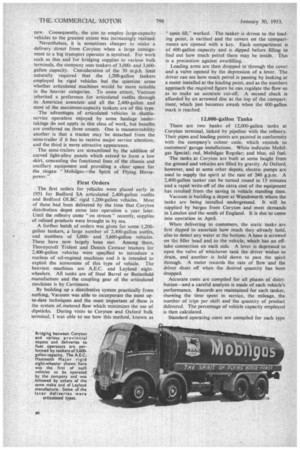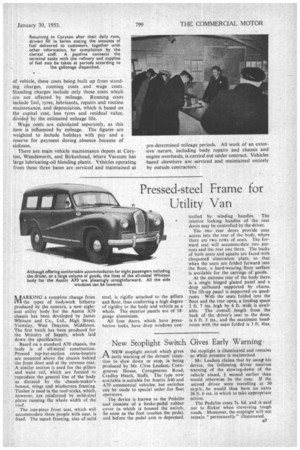1\1_ 311116
Page 114

Page 115

Page 116

Page 117

If you've noticed an error in this article please click here to report it so we can fix it.
BRANDED fuels return on Sunday, and among those on sale will be Mobilgas and Mobil Diesel, products that were not marketed in this country before the war, although they have been long established in many other countries throughout the world. Yet they might not have been made available here had
, it not been for a decision taken in 1950 by the Vacuum Oil Co., Ltd., to build a refinery to provide a home source of stock oils for motor and industrial lubricants.
The sum needed for this project was approximately £12m. and a financial reorganization of the company was undertaken which resulted in Socony-Vacuum, New York, and Powell Duffryn, the British coal and shipping group, becoming joint owners of Vacuum. In addition, Powell Duffryn made available a site at Coryton, Essex, for its construction.
Coryton refinery is not large compared with other similar post-war installations, for it was planned primarily to produce stock oils for lubricants. However, in the distillation process, 90 per cent of the imported crude petroleum remains after lubricating oils have been refined and economy naturally dictates that it be used for the production of various fuels. With a daily throughput of 17,700 barrels of crude, this meant that nearly 800,000 tons of fuel would be produced annually. Vacuum decided to market its petrol and oil fuel products direct. This caused the need for building up a distributive organization, entailing the creation of a, big road tanker fleet.
A marked change in petrol retailing in recent years has been the setting up of " solus " statiOns allied to one particular distributor and selling only one brand of product. Transport can be operated more cheaply if there are chains of _solus stations to be served from each depot than if vehicles have to make small drops at a large number of multi-brand stations, so the company, like its big competitors, favoured the current trend, although selected multi-brand stations are being supplied.
A large garage can sell about 25,000 gallons of petrol a month and if it has one supplier and adequate storage, drops of 2,400 gallons at three-day intervals are suitable and convenient. When a solus station has to be served, a tanker can be sent from its depot to discharge its load at the one point and then return, instead of having to deliver part-loads at several multi-brand stations. Also, the necessity to take small consignments to distant customers is largely obviated.
The company's distribution policy influenced its choice of vehicles. The advantages of the solus-station system. would be lost were high-payload tankers not to
be employed, and a vehicle of 2,400-gallon capacity was decided upon as the standard type for deliveries to consymers. As this vehicle would be restricted to 20 m.p.h., it meant that return journeys to points more than about 75 miles from a depot could not be completed within a day. A 30-m.p.h. vehicle could, however, run out some 100 miles distant and back and so a '1,200-gallon tanker was specified for use mainly in marginal districts beyond the most economical area of coverage of the bigger unit.
Plans for building bulk terminals at strategic points throughout the country were put into effect. The respective areas of these depots adjoin each other and as they were opened in sequence, what used to be the marginal "1,200-gallon tanker" area of one largely fell. into the' main " 2,400:gallon tanker" area of the
new. Consequently, the aim to employ large-capacity vehicles to the greatest extent was increasingly realized.
Nevertheless, it is sometimes cheaper to make a delivery direct from Coryton when a large consignment to a big transport operator is involved. For work such as this and for bridging supplies to various bulk terminals, the company uses tankers of 3,000and 3,600gallon capacity. Consideration of the 30 m.p.h. limit naturally required that the 1,200-gallon tankers employed be rigid vehicles but the question arose whether articulated machines would be more suitable in the heavier categories. To some extent, Vacuum inherited a preference for articulated outfits through its American associate and all the 2,400-gallon and most of the maximum-capacity tankers are of this type.
The advantages of articulated vehicles in shuttleservice operation enjoyed by some haulage undertakings do not apply in this class of work, but benefits are conferred on three counts. One is manceuvrability another is that a tractor may be detached from the semi-trailer if it has to receive major service attention; and the third is more attractive appearance.
The semi-trailers are streamlined by the addition of curved light-alloy panels which extend to form a low skirt, concealing the functional lines of the chassis and ancillary equipment and providing a clear space for the slogan " Mobilgas—the Spirit of Flying Horsepower."
First Orders The first orders for yehicles were placed early in 1951 for Bedford SA articulated 2,400-gallon outfits and Bedford OLBC rigid 1,200-gallon vehicles. Most of these had been delivered by the time that Coryton distribution depot came into operation a year later. Until the refinery came "on stream" recently, supplies of refined products were brought in by sea.
A further batch. of orders was given for some 1,200gallon tankers, a large number of 2,400-gallon outfits, and numbers of 3,000and 3,600-gallon vehicles. These have now largely been met. Among them, Thorn ycroft Trident and Dennis Centaur tractors for 2,400-gallon vehicles were specified to introduce a nucleus of oil-engined machines and it is intended to exploit the economies of this type of vehicle. The heaviest machines are A.E.C. and Leyland eight wheelers. All tanks are of Steel Barrel or Butterfield manufacture and the coupling gear of the articulated machines is by Carrimore.
By building up a distributive system practically from nothing, Vacuum was able to incorporate the most upto-date techniques and the most important of these is the system of metered flow which minimizes the use of dipsticks. During visits to Coryton and Oxford bulk terminal, I was able to see how this method, known as "open fill," worked. The tanker is driven to the loading point, is earthed and the covers on the compartments are opened with a key. Each compartment is of 600-gallon capacity and is dipped before filling to find out how much petrol there may be inside. This is a precaution against overfilling.
Loading arms are then dropped in throughthe cover and a valve opened by the depression of a lever. The driver can see how much petrol is passing by looking at a meter installed at the loading point, and as the numbers approach the required figure he can regulate the flow so as to make an accurate cut-off. A second check is afforded by an arrowed disc at the top of the compartment, which just becomes awash when the 600-gallon mark is reached.
12,000-gallon Tanks There are two banks of 12,000-gallon tanks at Coryton terminal, linked by pipeline with the refinery. Their pipes and loading points are painted in conformity with the company's colour code, which extends to customers garage installations. White indicates Mobilgas Special; red, Mobilgas Regular; and blue, oil fuel.
The tanks at Coryton are built at some height from the ground and vehicles are filled by gravity. At Oxford, however, and at some other depots, electric pumps are used to supply the spirit at the rate of 240 g.p.m. A 2,400-gallon tanker can be turned round in 15 minutes and a rapid write-off of the extra cost of the equipment has resulted from the saving in vehicle standing time.
Vacuum is building a depot at Wandsworth where the tanks are being installed underground. It will be supplied by barges from Coryton and meet demands in London and the south of England. It is due to come into operation in April.
When delivering to customers, the static tanks are first dipped to ascertain how much they already hold, also to detect any water at the bottom. A hose is screwed on the filler head and to the vehicle, which has an offtake connection on each side. A lever is depressed to open the valve of whichever tank the driver wishes to drain, and another is held down to pass the spirit through. A meter records the rate of flow and the driver shuts off when the desired quantity has been dropped.
Accurate costs are compiled for all phases of distribution—and a careful analysis is made of each vehicle's performance. Records are maintained for each tanker, showing the time spent in service, the mileage, the number of trips per shift and the quantity of product delivered. The percentage of vehicle capacity employed is then calculated.
Standard operating costs are compiled for each type of vehicle, these costs being built up from standing charges, running costs and wage costs. Standing charges include only those costs which are not affected by mileage. Running costs include fuel, tyres, lubricants, repairs and routine maintenance, and depreciation, which is based on the capital cost, less tyres and residual value, divided by the estimated mileage life.
Wage costs are calculated separately, as this item is influenced by mileage. The figures are weighted to include holidays with pay and a reserve for payment during absence because of sickness.
There are main -vehicle maintenance depots at Coryton, Wandsworth, and Birkenhead, where Vacuum has large lubricating-oil blending plants. Vehicles operating from these three bases are serviced and maintained at
























































































































































